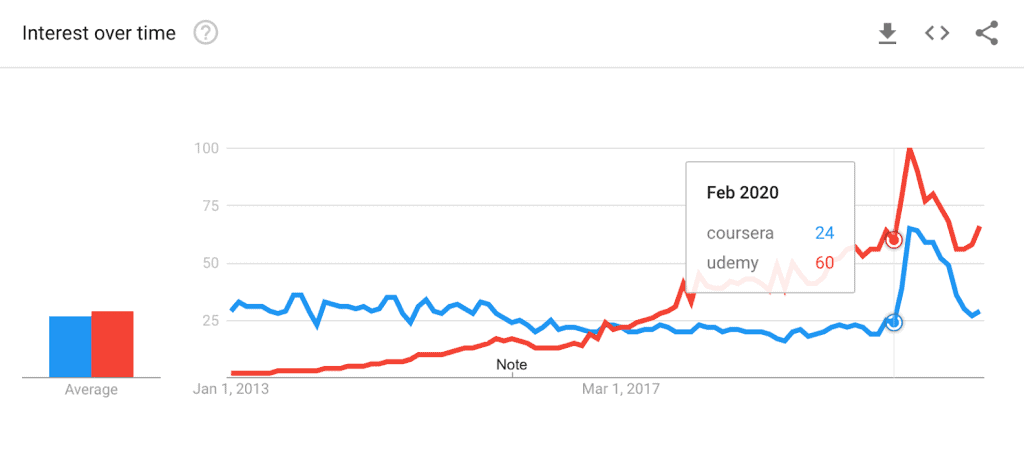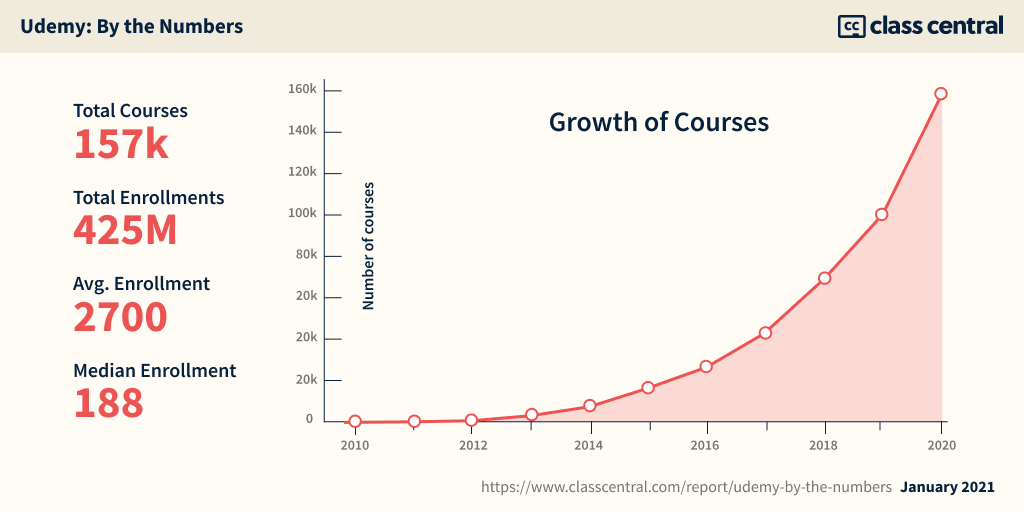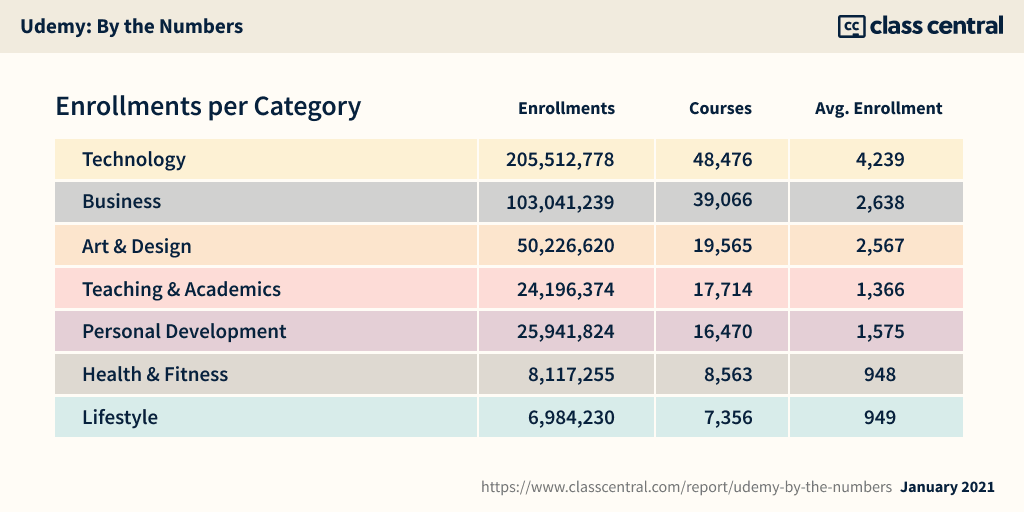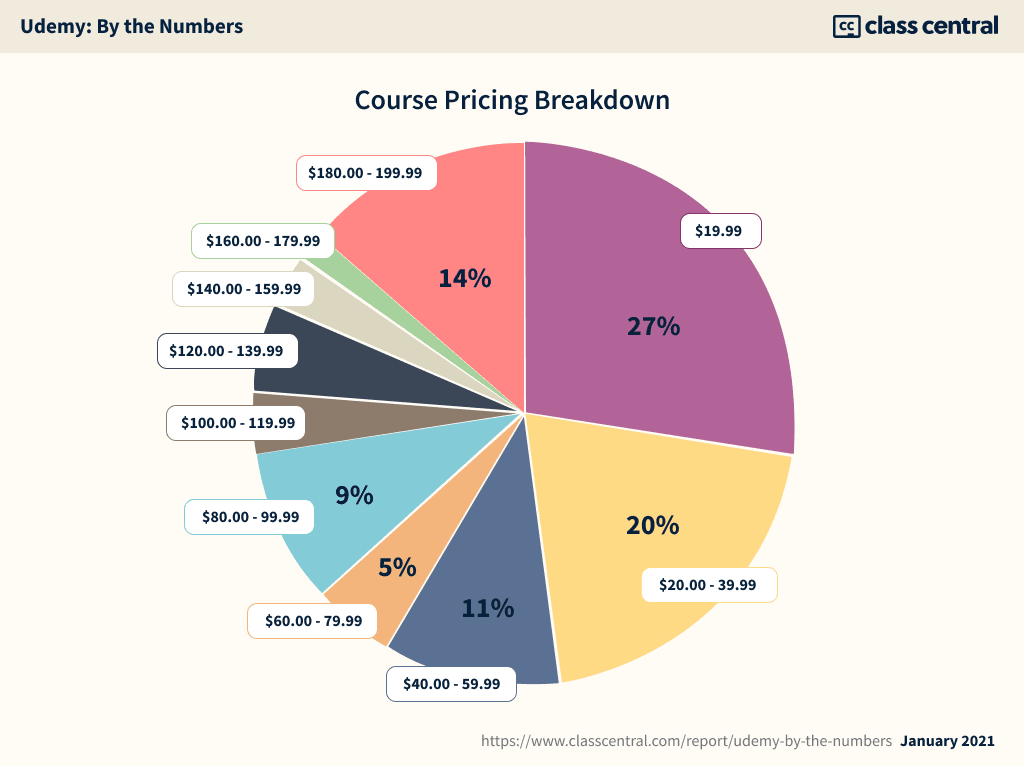Udemy vs Coursera: Comparing Online Learning Giants that Might IPO in 2021
Exploring the two providers in terms of their catalog, business model, web traffic, and more.
Boosted by the pandemic, 2020 was a record year for online course providers. Class Central has noted that one third of the learners that ever registered on a MOOC platform did so in 2020.
But unlike in the previous wave of interest for online education, i.e. the Year of the MOOC, new course providers aren’t being launched. Instead, the big ones are getting bigger.
As I mentioned in my 2020 overview, the Second Year of the MOOC, the pandemic allowed course providers to fast-forward a couple of years. From a growth standpoint, they’re now where they would have expected to be some two years down the road, absent the pandemic.
This has allowed two giants of this space, Coursera and Udemy, to bolster their valuation by over a billion dollars in 2020, putting them in a comfortable position to go public in 2021.
Recently, I analyzed Coursera’s 2020 and Udemy’s massive catalog of 157,000+ courses. In this article, I will try to compare the two online course providers across the board.
By the Numbers
| Coursera | Udemy | |
| Users | 76 million | 40 million |
| 2020 Revenue | >> $200 million | $400 million |
| Funding | $443 million | $296.5 million |
| Valuation | $2.5 billion | $3.25 billion |
| Courses | 6,500 | 157,000 |
| Enrollments | 170+ million | 425+ million |
| Enterprise Customers | 2,300+ | 7,000+ |
Udemy was launched in 2010, two years before Coursera. But Coursera started out stronger because it was founded by Stanford professors and propelled by the 2012 MOOC Hype.
Hence, Coursera was ahead in funding, users, and brand recognition. But over time, Udemy has closed the gap. And in some aspects, as you’ll see below, it has overtaken Coursera.
Udemy vs Coursera: Marketplace Approach & Catalog
Neither Udemy nor Coursera create their own courses. Instead, they operate as marketplaces. But their approaches differ in terms of who can create courses on the platforms.
Udemy is an open marketplace: anyone can create a course on the platform. Since 2010, this approach has turned Udemy into the world’s largest catalog of online courses, with 157,000 courses from over 57,000 instructors.
But most courses get few enrollments. While a couple have over 1 million enrollments, the median enrollment is just 188.
In a recent analysis of Udemy’s catalog, Class Central found that Udemy’s top-20% courses by enrollment account for 90% of all their enrollments. We also published a list of Udemy’s top 250 courses by enrollment.
Udemy courses tend to be vocational. Business and technology courses constitute 50% of the providers catalog, and they account for 70% of all the enrollments on the platform.
By contrast, Coursera is a curated marketplace: only certain universities (such as Stanford, Imperial, and Uniandes) and certain companies and organizations (such as Google, IBM, and The Linux Foundation) can create courses. Currently, Coursera’s website lists 230 partners.
Because of this, Coursera’s enrollments are spread across a significantly smaller number of courses than Udemy’s. As a result, mean enrollments are significantly higher. On Coursera, the average enrollment is 26K and the median is 6.5K.
The majority of the courses on Coursera are created by universities. Over the years, Coursera has partnered with 100+ universities around the globe. But they’ve been selective. Universities that aren’t highly ranked haven’t been allowed to offer courses on Coursera.
These different approaches translate into different courses offerings. Coursera tends to be more academic, while Udemy is more vocational. A simplistic way to put it is that you might want to learn about Design on Coursera, but you go to learn Photoshop on Udemy.
Recently, Coursera tried to plug this hole in their catalog by launching Guided Projects under the Coursera Project Network. These cost $9.99. Currently, there are over 1100 such courses. To speed up their creation, Coursera started accepting applications from “subject matter experts” worldwide via teach.coursera.org.
Another advantage of Coursera’s model and their university partnerships, is that they can offer different types of credential: from single courses to full-fledged degrees. Some of these credentials might be valued more in the job market than Udemy’s individual certificates.
Here’s the current state of Coursera’s catalog:
| Courses | 4,600 |
| Microcredentials | 650 |
| Degrees | 26 |
| Guided Projects | 1,100 |
Udemy vs Coursera: Business Model & Revenue
Udemy’s business model is simple: each course is sold individually and learners get lifetime access to it. There’s one exception: their Udemy Pro subscription, which offers a small curated collection of 24 courses for preparing for various IT certifications and costs $19.99 per month.
90% of Udemy courses are paid. Course prices range from $19.99 to $199.99 (without any discounts or deals). But Udemy is known to run a lot of promotions bringing the cost of the courses down.
On the B2B side of things, Udemy for Business costs $360/user/year for a catalog of 7,000+ courses, a small subset of their full catalog. They claim to have 7,000+ enterprise customers. In October 2020, Udemy announced that their enterprise business generated $100 million in annual recurring revenue.
According to Forbes, Udemy’s revenue likely exceeded $400 million in 2020.
Coursera’s business model, on the other hand, is a bit more complicated. Originally, the platform was completely free. It took several years of iterative changes to get to their model. I’ve written about the evolution of Coursera’s business model and the experiments they undertook along the way.
Generally speaking, here’s how how things work on Coursera: courses are free to take, but you need to upgrade to get access to graded assignments and earn a certificate. Upgrades are priced as follows:
- Single courses: you pay a fixed price and you get full access for six months.
- Specialization: you pay a subscription fee that starts at $39 per month.
Last year, Coursera officially launched Coursera Plus, a $399 annual catalog subscription that includes 90% of the provider’s catalog. More recently, Class Central reported that Coursera was testing a $59 monthly catalog subscription.
Catalog subscriptions were first offered to enterprises via Coursera for Business. Coursera claims to have 2,300 enterprise customers.
Their pandemic response also helped them make inroads into two business lines: Coursera for Campus and Coursera for Government, which offer similar services to universities and governments worldwide, respectively.
In addition, Coursera has 26 online degrees that cost $10K to $45K. Illinois’ iMBA and the University of London’s Bachelor of Computer Science each have over 1,000 students enrolled.
According to The New York Times, before the pandemic, Coursera projected its revenue to grow 30% in 2020 to over $200 million. The pandemic pushed the provider well past that number. According to Coursera, they have $300 million in cash balance — that is, of money on hand.
Udemy vs Coursera: Brand Recognition

To compare the Udemy and Coursera brands somewhat objectively, I looked at Google Trends, using searches for the providers’ names as proxies for brand recognition.
Propelled by the 2012 MOOC Hype, Coursera’s brand initially enjoyed a comfortable lead. But around November 2016, Udemy surpassed Coursera in terms of searches. And searches for Coursera stagnated, while Udemy’s kept growing.
Both brands got a boost in March and April 2020 due to the COVID-19 pandemic. Worldwide, they experienced a similar boost. However, in the US, Coursera was able to narrow the gap with Udemy.
Coursera’s strong pandemic response might have something to do with it. Most notably, Coursera responded to the pandemic with a number of free offerings. For instance, they offered 115 courses with free certificates. On Class Central alone, the article generated 3 million views.
The pandemic and Coursera’s timely response allowed them to gain 31 million new learners in 2020 alone. Over the previous 8 years, the company had gained 45 million learners in total.
To learn more about the provider’s pandemic response, check our analysis of Coursera’s 2020.
Udemy vs Coursera: Web Traffic & SEO
| Udemy | Coursera | |
| Alexa Rank | 109 | 273 |
| SimilarWeb Traffic (Dec 2020) | 101 million | 49 million |
| SpyFu (SEO Traffic) | 5.85 million | 16.1 million |
| Semrush (SEO Traffic) | 10.5 million | 8.6 million |
| SimilarWeb (SEO Traffic) | 20.5 million | 11.2 million |
When it comes to how many people visit each website, Udemy has a clear lead. According to SimilarWeb, Udemy sees twice as many sessions as Coursera. This can be attributed to Udemy’s broad catalog of online courses.
I’ve written about Google’s importance in the success of online learning platforms and how providers like Coursera, edX, and MasterClass optimize their content for search engines.
SpyFu puts Coursera ahead of Udemy. But SimilarWeb and Semrush have Udemy ahead. Based on my experience running Class Central for almost a decade, I suspect Udemy is well ahead of Coursera in terms of traffic.
Udemy vs Coursera: Product
In terms of features, Coursera pulls ahead in one particular area: grading and assignments. But they need to, since they position themselves as a more academic platform. For instance, in the context of online degrees, more advanced quizzes are required.
Coursera assignments include peer feedback, autograders, and Jupyter Notebooks integration, in addition to simpler assignments such as multiple-choice questions.
Coursera’s Guided Projects, a product of their acquisition of Rhyme in 2019, feature a side-by-side virtual desktop and video lessons, supposed to make it easier to follow along.
By contrast, Udemy has simpler assignments and less variety. They’ve offered for some time the ability to create autograded coding exercises. But these are seldom used. Of Udemy’s 157,000 courses, only 600 have this sort of coding exercises.
One significant difference between both providers is how they handle interaction between instructors and students, and among students themselves.
Coursera directs learners to forums, with uneven levels of instructor and student activity. By contrast, Udemy has individual Q&As underneath each course section, increasing visibility of the feature and encouraging targeted interactions around the course content.
Tags











Trees Whitbeck
I found this article very interesting. Thanks for all the research.
Ray
Thanks for the interesting article.